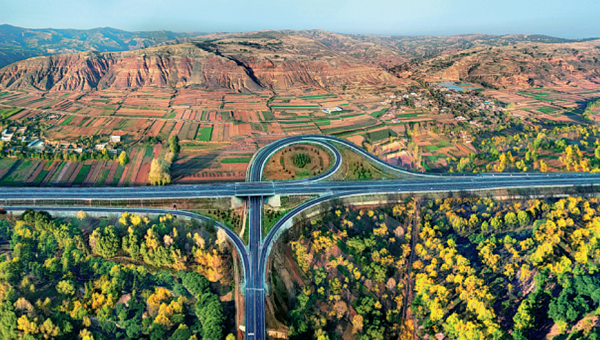Expressway an economic engine for inland areas

A section of the Lanzhou-Haikou Expressway in Gansu province. PROVIDED TO CHINA DAILY
Heavily loaded trucks leave the inland municipality of Chongqing in southwestern China, heading south down the G75, a main national expressway, to coastal ports in the Guangxi Zhuang autonomous region, where their cargo will be loaded onto ships and sent around the world.
Compared with the traditional export route from Chongqing via the Yangtze River to ports in Shanghai, which usually takes 11 to 16 days, the journey to port via the expressway takes one to two days.
The G75 starts in Lanzhou, capital of the northwestern province of Gansu, and ends in the coastal city of Haikou, capital of South China's Hainan province.
The Ministry of Transport says it is one of 11 north-south expressways in China and passes through seven provincial-level regions, including the provinces of Gansu, Sichuan, Guizhou, Guangdong and Hainan, as well as Chongqing and Guangxi.
An important part of the national highway network, the G75 connects inland regions in northwestern and southwestern China with the country's southern coast.
It will eventually run for 2,439 kilometers, with 2,389 km already open to traffic. Two sections in Gansu and Hainan are under construction, with the one in Hainan expected to open next year and the one in Gansu in 2023.
"The expressway has several roles-a shortcut from inland areas to the southern coastal gateway, a fast passage linking two inland regions and also the first expressway in some remote areas," said Wang Hengbin, an official from the ministry's highway bureau. "It is one of the most convenient passages to travel between the northwestern and southwestern regions."
The section linking Chongqing and Sichuan with Guangxi is an important part of the New Western Land-Sea Corridor, Wang said.
Global connections
Li Ping, head of Chongqing Guizhou Expressway, a Chongqing Expressway subsidiary that operates a section of the G75 in the municipality, said the expressway is Chongqing's first high-speed channel to the sea and plays an important role in highway logistics.
He said that promotion of the New Western Land-Sea Corridor, a trade passage connecting inland cities in southwestern China with the world, has seen the number of trucks running on a section of the highway linking Chongqing and Guizhou increase by 43 percent in three years.
"Behind the busy logistics, it reflects that inland areas in the western region have been accelerating to open up," Li said.
Cargo from inland China can be transported to the border via the corridor for shipment to Southeast Asian countries and then on to other parts of the world. Imports can also use the route to enter China.
It has become a major national project and was written into China's 14th Five-Year Plan (2021-25).
Li said that in recent years, the expressway's road surface and tunnels have been improved and more trees and bushes have been planted alongside it, aiming to provide high-quality travel experiences to the public and also boost regional socioeconomic development.
Infrastructure facilities have also been upgraded to better link logistics and industrial parks by allowing larger trucks to pass through.
Li said the company uses a smart platform to monitor and administer tunnels along the section because Chongqing and Guizhou are known for their mountainous terrain.
"The 'smart' expressway has enhanced the management capability of highways in mountainous southwestern areas," he said.
Truck driver Sun Kunyu has witnessed traffic growth along the way.
"The road has become much busier and sometimes crowded," he said.
The 32-year-old has been driving heavily loaded trucks on the expressway for more than a decade, transporting construction materials between downtown Chongqing and Qijiang, a remote district of the municipality.
The round trip takes more than two hours and he usually makes two to three journeys a day.
"The expressway has improved constantly," he said. "When there is a broken section, it will be mended immediately."
Sun earns about 20,000 yuan ($3,100) a month driving trucks and said the six-lane road is "bread" for his family.














